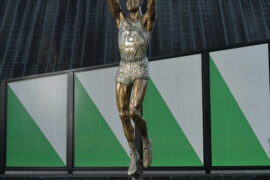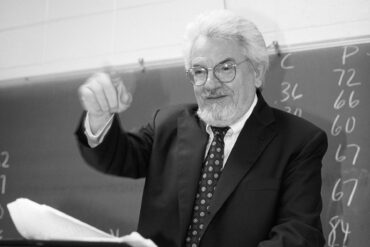an industry is born
By Bos Johnson
HQ 11 | SPRING 1992
October 15, 1949. The few lucky Tri-State residents who owned black-and-white television sets sat mesmerized. Others gathered on downtown Huntington streets outside store windows dominated by the big cabinets with the small screens. From those screens came the area’s first television image: a test pattern, followed by a list of TV set distributors. Then, more test pattern.
A lifeless chart, really nothing more than lines and circles, thus became television’s first “star,” and the subject of endless conversation. “Did you see it? How’s your picture? Imagine, pictures right through the air!”
That was the beginning of Channel 5 (now Channel 3), WSAZ-TV -the beginning of television – for more than 2 million people.
What they were to see was denied to much of the United States until the mid 1950s. The Federal Communications Commission (FCC) had licensed only 119 stations (there are more than 100 today), then imposed a four-year nationwide halt (“The Freeze,” it was called) on all TV development, while it sorted out a number of technical concerns. WSAZ-TV got its permit in late 1948, just 24 hours before that freeze; it would be the last station to get on the air until 1953.
Now back to 1949. Nine days after the debut of the test pattern, viewers saw “Stop the Music,” the first regular entertainment program televised through much of West Virginia, plus large areas of Ohio, Kentucky, Virginia, and Tennessee.
Less than a month later, on grand-opening day (Nov. 15), roughly 2,200 TV sets were tuned to Channel 5 for Kukla, Fran and Ollie; Hopalong Cassidy and Toscanini conducting the New York Philharmonic. And television was born.
The presidents of RCA and NBC joined Gov. Okey Patterson as honored guests for that opening gala in the old Governor Cabell Hotel. It was a sparkling affair, hosted by Huntington Publishing Company (which owned The Herald-Dispatch and the afternoon Huntington Advertiser) and its subsidiary, WSAZinc., which had brought the area’s first radio station from Pomeroy, Ohio, to Huntington in 1923.

Now the principals of those companies, newspaper executives Col. J.H. Long and Dave Gideon, plus broadcaster Capt.John Kennedy, had become the first- and until 1953 the only- TV owners in West Virginia. The creative genius, however, was the colonel’s young grandson-in-law, Lawrence H. (Bud) Rogers. It was he who developed the two city (Huntington-Charleston) regional market concept – first in the country for TV. He built a station that acted like a “big city” facility while located in two relatively small communities.
Within the first 10 days, Rogers’ station demonstrated what would become its trademark – an aggressive commitment to local news, sports, and public affairs.
Local Service:
News-sports-farm-weather
On Thanksgiving Day, when Marshall College played Xavier University at Fairfield Stadium, Jack Bradley delivered the first live television play-by-play in the state. By December, the station inaugurated an 18-game schedule of Marshall basketball telecast, originating from the old Radio Center. Bradley became a television play-by-play fixture in a day when few other stations were equipped for live sports. By the time Jim Thacker succeeded him as radio/TV sports director in the mid 1950s, the pattern was established. University of Kentucky and Ohio University basketball came quickly. And in 1959, when Jerry West led the West Virginia University basketball team to the “Final Four” in Louisville, Thacker televised the games live – another first for the region. Thacker would be named national Outstanding Sportscaster in 1962 before moving to North Carolina and network sports assignments.
First in news
It was for regional news, however, that the station would become best know.
After some early experimentation, Rogers hired West Virginia native Nick Basso in 1951 to establish the first full-time news operation. Basso brought in three young West Virginia newspaper-trained reporters plus Professor Paul Krakowski, who had been teaching radio news at WVU. Together, they began to teach each other about television -trial and error, on-the-job. “We were creating-and changing-the rules every day,” Basso recalls. “No one knew what was right, so we kept experimenting until we learned what worked. We really were creating an industry.”
The original news staff consisted of Don McClure, now a Washington consultant; Jim Millstone, an editor with the St. Louis Post-Dispatch, and Len Gross who later would enter public relations with Consolidation Coal, then moved to Episcopal ministry.
While most stations were presenting three-day-old movie theater newsreels on their newscasts, this staff took bulky film cameras into the hills of the TriState and the halls of government.
Their leader, Basso, also became the area’s first TV anchor personality. In a remarkable record for television, only four people have sat at that 6 p.m. news anchor desk in Huntington during more than 40 years – Basso (1951-60), Bos Johnson (l 960-76), Bob Brunner (l976-86) and the current occupant, Bob Smith.
By 1954, the news operation was recognized nationwide; WSAZ-TV was named Outstanding News Operation by the Radio Television News Directors Association.
A year earlier, WSAZ-TV had become the first station allowed to take news film cameras onto the floor of a state legislature (W.Va.), and in 1956 produced the nation’s first full coverage of a legislative opening day – also on film. For the first time, viewers could see Gov. William Marland’s State of the State speech. The following year the new governor, Cecil Underwood, would make his legislative address on WSAZTV live – routine today, remarkable then.
When the famous West Virginia Kennedy-Humphrey primary campaign roared into election day 1960, NBC tested its new election tabulating system in WSAZ’s Charleston studio. The NBC/WSAZ returns were so far ahead of the wire services, the New York Times was forced to use them in its stories.
By 1972, the use of live coverage became accepted and expected; on election night, for example, the station covered campaign headquarters of both W.Va. gubernatorial candidates live. Today such coverage extends to Kentucky and Ohio.
As the years flew by, a series of national broadcast news professionals would receive their early training at WSAZ-TV:
The late Bill Stewart, killed in Nicaragua while reporting for ABC-TV, anchored WSAZ’s 11 p.m. news in the mid 1960s.

Fred Briggs, veteran NBC correspondent, created a major WSAZ-Radio news program in the late 1950s, but was best known on TV as “Gaylord,” a Saturday night horror-movie host.
Roger O’Neil, correspondent and Denver bureau chief, NBC News, anchored the 11 p.m. news in the early 1970s.
Dick Ford, KSDK-TV (St. Louis) anchor for more than 20 years, anchored and produced the late news on Channel 3 in 1961-62.
Neil Boggs, for years an NBC correspondent and the principal anchor for WRC-TV, Washington, had learned television at WSAZ-TV in Charleston.
Two presidents of the international Radio Television News Directors Association came from the station: Bos Johnson and Bob Brunner. No other TV station has ever produced two leaders of the industry’s national organization. Brunner is now Gov. Gaston Caperton’s communications director.
The station’s dominance was reflected regularly in the ratings. On election nights – long after other stations had come on the air – WSAZ still would be watched by up to 74 percent of the audience.
During the 1960s and 1970s, the station’s 6 p.m. newscast was frequently the highest rated news program among the nation’s 50 largest markets. It remains today one of the highest in the country.
The Big Stick & a Second Home
The news people, however, gave credit where it was due – their success was, in large measure, a tribute to the power of the station’s transmitter and the height and effectiveness of its tower. Rising 1,253 feet above average terrain on Barker’s Ridge near Huntington, the tower combined with a low channel and strong signal power to propel a clear signal deep into the Appalachian Mountains. At the time it was built, the tower was one of the tallest structures in the United States.
Even in recent years, rating services report as many as 2 3 of the region’s most watched programs were aired by WSAZTV, a tribute to viewer habits built on the power and clarity of the over-the-air signal, despite growing public reliance on cable systems.
Tower and power were only two of a string of technical innovations that successive ownerships provided. WSAZ built a remote truck when it first went on the air. When AT&T was unable to provide network transmission service, the station built its own microwave system (1950) to bring live network programs – from all the networks – to its audience. When color TV arrived, WSAZ purchased the fourth color transmitter made in the United States.
“The station was blessed with responsible owners right from the start,” according to John Clay, retired chief engineer. Clay, a member of the original engineering staff, watched corporate owners spend millions of dollars to keep the station’s technical operation state-of-the-art.
After the local owners sold the station to \VJR-Goodwill Stations of Detroit, a subsequent purchaser was Capital Cities Broadcasting (now owners of ABC networks). Lee Enterprises, an Iowa-based newspaper/broadcast operator, became the owner in 1971; by 1993, Lee will become the station’s longest-term owner.
Chief among the technical innovations came in 1954, when the station opened a Charleston studio, 50 miles from Huntington, again building its own microwave system to deliver the signal to its transmitter. By September of that year, the News Picture (6 and 11 p.m.) programs became the first in the nation to utilize a dual city operation, with Charleston native Bob Horan the first reporter.
Two years later, NBC executives would come to Huntington to learn from WSAZTV as they prepared to launch the famous two-city Huntley-Brinkley Report.
News information came in many packages. In the early 50s, farmers depended upon WSAZ-TV for information- because the station hired veteran Cabell County agricultural agent William D. “Farmer Bill” Click. It was said, only partly in jest, that if the respected Farmer Bill had ever told area farmers not to plant, widespread famine would result. His slow, casual approach – not at all television-slick- perfectly conveyed his essential credibility.
When Bill Click died in 1960, successor John Heiskell came from Ohio to continue the tradition for another decade with the same down-home reliability. Today, John Mara carries on the farm reporting tradition.
One of the longest-tenured personalities on WSAZ newscasts, however, reported not news but weather. From the early days well into the 1980s, “D. ].,” Dorothy Jeanne Schroeder fascinated audiences not only with her weather reports, but also with her seemingly limitless wardrobe.
Today, many television stations hire professional meteorologists for the exacting business of weather reporting (Tony Cavalier of WSAZ-TV is the only one currently in this market). Many forget, however, that in 1960 the station installed radar weather and hired the region’s first broadcast meteorologist, Jom Combs, who retired from the U.S. Weather Service to bring his Texas drawl to the Tri-State.
After several years with the station, he burst in on the general manager one day and told him he was quitting. “Why?” he was asked. “Because,” Combs replied. “I’m tired of the weather in these mountains making a fool out of me.” As Cavalier will testify, even with improved equipment, forecasting weather in this region continues to be a tricky business.
The Golden Years
National television historians call the decade beginning in 1954 “The Golden Years” of television. For WSAZ-TV, those were the years of developing local personalities and programs which linger in Tri-State memories long after they have faded from TV screens. For “senior” readers, here is a quick memory check. Do you remember:
“Saturday Night Jamboree” (1952) originated live from the 14th floor of the West Virginia building, where director Fritz Leichner taught dancers how to cavort in a converted-office studio (until moving to the station’s new home in 1953). Hosted by the late Dean Sturm, the Jamboree proved perhaps the most durable live program in the region, airing weekly for over 18 years. It also offered the original TV exposure for regional country western artists such as Texas Slim, Bobby Barre, Connie Smith, Ralph Shannon, Odey Crabtree, and Hylo Brown. Nationally known performers Flatt and Scruggs and Porter Waggoner appeared regularly in those early years. They were in Huntington anyway, coming to record their own TV programs because WSAZ-TV had two videotape recorders (a rarity in the early days). The station then “dubbed” (rerecorded) the programs for the rest of the nation.
“Coffee Time,” hosted by Budd Dailey, and later by Dean Sturm, featured Brownie Benson’s music and the voices of Jule Huffman and Sue Chambers. Clubs and community groups traveled hours in the pre-dawn darkness to sit in the audience for this live 9 a.m. variety program.
“Twilight Time,” another musical creation of the station’s veteran production manager, Fritz Leichner, also featured the Brownie Benson combo with dinner-hour live music.
“Parson’s Study” (1954) with Rev. Griffin Callahan, discussed listener’s moral and religious problems on live TV. The Rev. Arthur Beckett continued the program when Callahan left Huntington.
“The Old Timer,” Bob Mills, began regular children’s programming in 19 5 3. “Aunt Dru,” (Mickey Banga), followed in 19 5 5. Mickey was succeeded by Don Waggoner as the “Beachcomber” and George Lewis as “Steamboat Bill,” before Jule Hoffman began his still-running 22 years as “Mister Cartoon.”

During Waggoner’s time, he was once installed on a tiny island in the Kanawha River at Charleston, where he aired the program live for several days. As a climax, he was lifted from the island by a cable dropped from a helicopter hovering overhead, while a riverbank crowd cheered, and station officials held their collective breath.
Veteran WSAZ Program Manager George M. (Mickey) Curry calls that live children’s program “critical to building audience loyalty.” Over more than 30years, he estimates 250 thousand children came to the studio from throughout the region – and formed a bond with the station which lasted into adulthood.
“Current” (1956) featured Bob and Jan Carr. When color came to WSAZTV(achartermemberof theNBC color network), the station presented four hours of local live color each day. “Current” was the first, aired for an hour each afternoon, including a kitchen segment featuring Marge Ramsey. The kitchen concept had been originated earlier by Maida Shoemaker.
“Today,” already an NBC network staple, came live to Huntington in 19 5 6. Dave Garraway, Frank Blair, Jack Lescoulie, Lee Ann Merriweather – and J. Fred Muggs, the chimp – broadcast live from a sternwheeler on the Ohio River, promoting economic development potential of the Mid Ohio Valley. The previous Sunday, the network had broadcast a live steamboat race from the Ohio River for “Wide, Wide World” – only to have the network control center in New York miss the exciting finish.
In 1992, the beat goes on. The station now has the region’s only fully computerized newsroom, the largest staff, continued strong ratings. But neither it nor any other station can ever again experience the excitement of the early years.
“How many people ever have the chance to create an industry?” asks current WSAZ-TV General Manager Don Ray. “Those pioneers had a once-in-a-lifetime opportunity, and they took full advantage of it.”
Today, the Tri-State – and the broadcasting industry – still reap the benefits.





